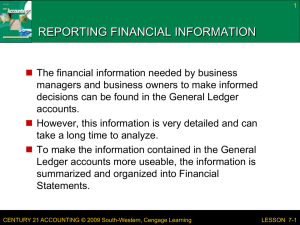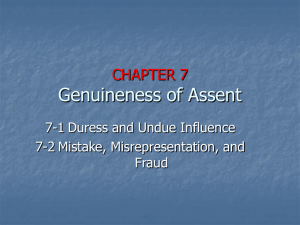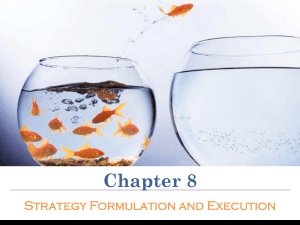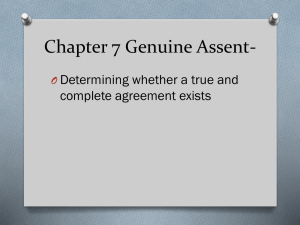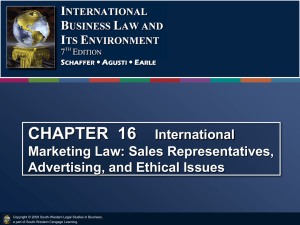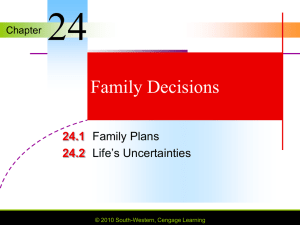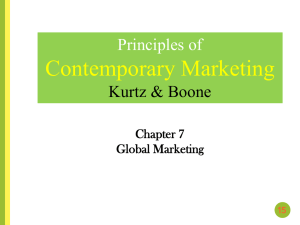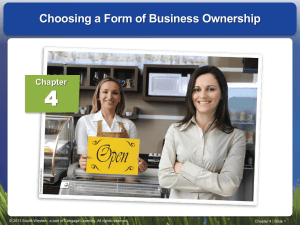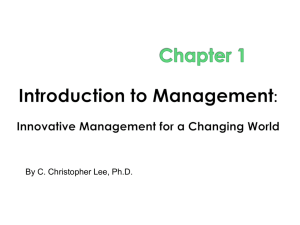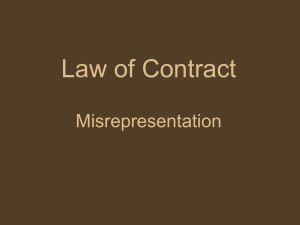CHAPTER 7 Genuineness of Assent
advertisement
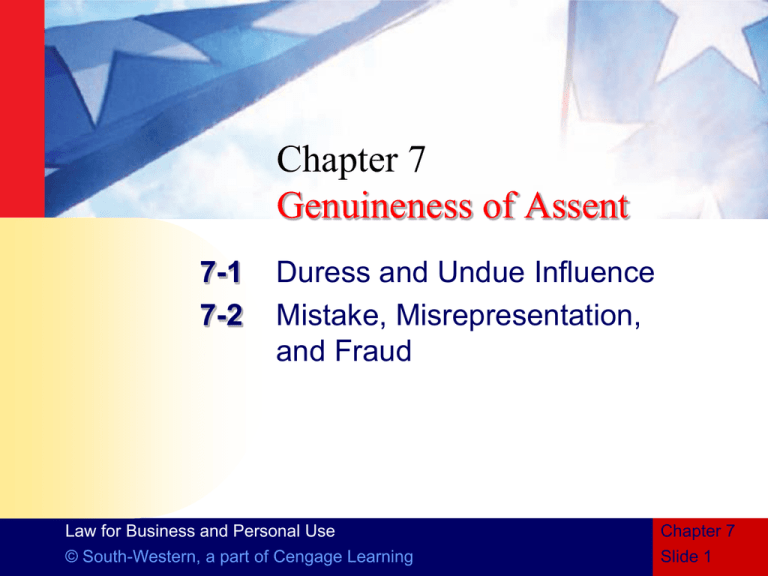
Chapter 7 Genuineness of Assent 7-1 7-2 Duress and Undue Influence Mistake, Misrepresentation, and Fraud Law for Business and Personal Use Chapter 7 © South-Western, a part of Cengage Learning Slide 1 7-1 Duress and Undue Influence GOALS Recognize when genuine assent is not present Identify the two key elements in undue influence Law for Business and Personal Use Chapter 7 © South-Western, a part of Cengage Learning Slide 2 GENUINE ASSENT AND DURESS Due to a variety of causes, genuine assent (true and complete agreement) is at times shown to be lacking in court. Without genuine assent a contract is typically voidable. This means that, if the injured party desires, that party can cancel the contractual obligation. The party then has the legal right to get back what has already been put into the contract. This action is referred to rescission. Law for Business and Personal Use Chapter 7 © South-Western, a part of Cengage Learning Slide 3 GENUINE ASSENT AND DURESS Genuine assent (cont.) To be effective, an avoidance must be prompt. It must occur shortly after discovering there is no genuine agreement Avoidance must occur before the contract is ratified. Ratification is conduct that confirms one intends to be bound by the contract. Law for Business and Personal Use Chapter 7 © South-Western, a part of Cengage Learning Slide 4 GENUINE ASSENT AND DURESS Duress – The law only allows a contract to be undone because of apprehension and pressure in a few instances. Actionable or legal duress only occurs when one party uses an improper threat to act or obtain an expression of agreement. The resulting contract is voidable. Much of the law of duress focuses on the nature of the threat. Law for Business and Personal Use Chapter 7 © South-Western, a part of Cengage Learning Slide 5 GENUINE ASSENT AND DURESS Duress (cont.) Threats of illegal or tortious conduct – The threat to engage in illegal or tortious conduct, such as a crime or tort, to win agreement is always duress. The threat may be to the physical life, liberty, or property of the victim. Threats to report crimes – If one uses the threat of reporting a crime to force the criminal to contract, this is duress and may be the crime of extortion. Law for Business and Personal Use Chapter 7 © South-Western, a part of Cengage Learning Slide 6 GENUINE ASSENT AND DURESS Duress (cont.) Threats to sue – When the threat to sue is made for purpose unrelated to the suit, this may be duress and the resulting contract may be voidable. Economic threats – Parties may be tempted to use the economic power they have over one another to negotiate a favorable modification or settlement. The courts look at both the threat and the alternatives available to the threatened party. It is duress if the threatened party had no other choices but to enter into or modify the contract. Law for Business and Personal Use Chapter 7 © South-Western, a part of Cengage Learning Slide 7 List the various forms of legal duress. Law for Business and Personal Use Chapter 7 © South-Western, a part of Cengage Learning Slide 8 UNDUE INFLUENCE AND ASSENT Undue influence occurs when one party to the contract is in a position of trust and wrongfully dominates the other party. The dominated person then does not exercise free will in accepting the contractual terms. The two key elements in undue influence are the relationship and the wrongful or unfair persuasion. When a contract arises because of undue influence, it is voidable by the victim. Law for Business and Personal Use Chapter 7 © South-Western, a part of Cengage Learning Slide 9 UNDUE INFLUENCE AND ASSENT The relationship – A relationship of trust, confidence, or authority must exist between the parties to the contract. Examples include attorney/client, husband/wife, physician/ patient. Unfair persuasion – Often the best evidence of unfair persuasion is found in the terms of the contract. Law for Business and Personal Use Chapter 7 © South-Western, a part of Cengage Learning Slide 10 UNDUE INFLUENCE AND ASSENT To prevent a claim of undue influence, the stronger party should act with total honesty, fully disclose all important facts, and insist that the weaker party obtain independent counsel before contracting. Law for Business and Personal Use Chapter 7 © South-Western, a part of Cengage Learning Slide 11 What are the key elements in undue influence? Law for Business and Personal Use Chapter 7 © South-Western, a part of Cengage Learning Slide 12 7-2 Mistake, Misrepresentation, and Fraud GOALS Recognize the types of mistakes that can make a contract voidable or void List the criteria for a statement to be treated as a misrepresentation Define fraud and describe the remedies for it Law for Business and Personal Use Chapter 7 © South-Western, a part of Cengage Learning Slide 13 WHAT ARE THE TYPES OF CONTRACTUAL MISTAKES? Unilateral mistakes – A unilateral mistake occurs when only one party holds an incorrect belief about the facts or law related to a contract. Generally, this does not affect the validity of the contract. Common unilateral mistakes include: Failure to read a contract before signing Hurried or careless reading of a contract Signing a contract in a language one does not understand Law for Business and Personal Use Chapter 7 © South-Western, a part of Cengage Learning Slide 14 WHAT ARE THE TYPES OF CONTRACTUAL MISTAKES? Mutual mistakes – When there is a mutual mistake (also called a bilateral mistake) both parties have an incorrect belief about an important fact or the applicable law. Important facts that influence the parties’ decisions about a contract are called material facts. Law for Business and Personal Use Chapter 7 © South-Western, a part of Cengage Learning Slide 15 WHAT ARE THE TYPES OF CONTRACTUAL MISTAKES? Mutual mistakes (cont.) If a mutual mistake of fact occurs, the contract is void (without legal effect). When the mutual mistake is about the applicable law, the contract is still valid. Law for Business and Personal Use Chapter 7 © South-Western, a part of Cengage Learning Slide 16 Name the types of mistakes that can make a contract voidable or void. Law for Business and Personal Use Chapter 7 © South-Western, a part of Cengage Learning Slide 17 WHAT IS MISREPRESENTATION? In many contract negotiations, the parties make statements that turn out to be untrue. This is an innocent misrepresentation. If a party knowingly makes an untrue statement, the party has engaged in fraudulent misrepresentation. In both of these situations, the contract that results is voidable by the party to whom the misrepresentation is made. Law for Business and Personal Use Chapter 7 © South-Western, a part of Cengage Learning Slide 18 WHAT IS MISREPRESENTATION? Statements are treated as misrepresentations by the law only if: 1. The untrue statement is one of fact or there is active concealment 2. The statement is material to the transaction or is fraudulent 3. The victim reasonably relied on the statement Law for Business and Personal Use Chapter 7 © South-Western, a part of Cengage Learning Slide 19 WHAT IS MISREPRESENTATION? Untrue statement of fact – In misrepresentation, the statement must be one of fact rather than opinion. Therefore, the statement must be about a past or existing fact. Opinions also can be distinguished from facts based on how concrete they are. When an expert expresses an opinion, the law will treat the statement as a statement of fact which can be the basis for misrepresentation. Law for Business and Personal Use Chapter 7 © South-Western, a part of Cengage Learning Slide 20 WHAT IS MISREPRESENTATION? Untrue statement of fact (cont.) Active concealment – Active concealment is a substitute for a false statement. Silence – While in many situations the seller may remain silent about defects, there are three important situations where disclosure is required: 1. A statement about a material fact omits important information (half truths). 2. A true statement is made false by subsequent events. 3. One party knows the other party has made a basic mistaken assumption. Law for Business and Personal Use Chapter 7 © South-Western, a part of Cengage Learning Slide 21 WHAT IS MISREPRESENTATION? Materiality – There are three ways an untrue statement can be determined to be material: 1. The statement would cause a reasonable person to contract. 2. The defendant knew this plaintiff would rely on the statement. 3. If the defendant knew the statement was false, this makes the statement material. Law for Business and Personal Use Chapter 7 © South-Western, a part of Cengage Learning Slide 22 WHAT IS MISREPRESENTATION? Reasonable reliance – Even though the statement is material, there is no misrepresentation unless the victim reasonable relied on it. Law for Business and Personal Use Chapter 7 © South-Western, a part of Cengage Learning Slide 23 What are the three criteria for a statement to be treated as a misrepresentation? Law for Business and Personal Use Chapter 7 © South-Western, a part of Cengage Learning Slide 24 FRAUD AND REMEDIES FOR FRAUD Fraud is based on misrepresentation. All the elements of misrepresentation must be proven to show fraud plus two additional elements: intent and injury. The misrepresentation must be intentional or reckless Person deliberately lies or conceals a material fact Law for Business and Personal Use Chapter 7 © South-Western, a part of Cengage Learning Slide 25 FRAUD AND REMEDIES FOR FRAUD The misrepresentation must be intentional or reckless (cont.) Person recklessly makes a false statement of fact without knowing whether it is true or false. Misrepresentation must be intended to induce the victim to contract. Law for Business and Personal Use Chapter 7 © South-Western, a part of Cengage Learning Slide 26 FRAUD AND REMEDIES FOR FRAUD The misrepresentation or concealment must injure – To establish fraud, there must be proof of injury. If there is an intentional misrepresentation, but no injuries, there is no liability for fraud. Law for Business and Personal Use Chapter 7 © South-Western, a part of Cengage Learning Slide 27 REMEDIES FOR FRAUD Rescission – Contracts entered into as a result of misrepresentation or fraud are voidable by the injured party and can be rescinded. Normally when one rescinds, anything received must be returned. A deceived party who has performed part of the contract may recover what has been paid or given. A deceived party who has done nothing may cancel the contract with no further obligation. Law for Business and Personal Use Chapter 7 © South-Western, a part of Cengage Learning Slide 28 REMEDIES FOR FRAUD Damages – Damages are available if fraud is proven. Should a defrauded party nonetheless choose to ratify the contract, the defrauded party may seek damages for loss created by the fraud. Under UCC, damages are available when there is only an innocent misrepresentation in a sale of goods. Law for Business and Personal Use Chapter 7 © South-Western, a part of Cengage Learning Slide 29 REMEDIES FOR FRAUD Punitive damages – Punitive damages are also available as a way to punish the party who committed fraud. Law for Business and Personal Use Chapter 7 © South-Western, a part of Cengage Learning Slide 30 What are the remedies available for fraud? Law for Business and Personal Use Chapter 7 © South-Western, a part of Cengage Learning Slide 31 PREVENT LEGAL DIFFICULTIES In making contracts . . . Research important transactions before entering into them. Verify claims of the seller by outside means or through firsthand personal experience. Do not rush into a decision. Take time to review and understand the advantages and disadvantages of the proposed contract. Legitimate proposals will usually survive a delay. Continued on the next slide Law for Business and Personal Use Chapter 7 © South-Western, a part of Cengage Learning Slide 32 PREVENT LEGAL DIFFICULTIES Do not hesitate to ask questions about vague or uncovered issues. Forcing the other party to make statements about them may lay the groundwork for proving fraud or misrepresentation later. If the other party does not properly answer your questions, proceed with great caution or abandon the negotiations. If you believe you have been defrauded, act promptly to rescind the contract. Law for Business and Personal Use Chapter 7 © South-Western, a part of Cengage Learning Slide 33
